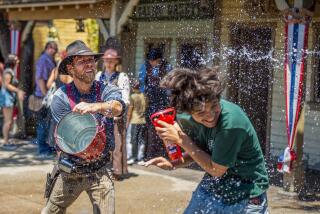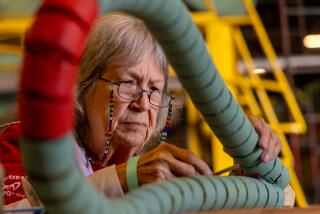Carnival Crews
On the edge of the Orange County Fair lives a floating town. Inside its canvas walls, babies are born and weddings take place. Here the scent of burning sugar from cotton candy wafts in from the fun zone and mingles with the smell of just-cleaned laundry, and the noise of the carnival and the grinding rush of the crowd becomes distant.
The stretch of patchy grass, where the mobile homes and tents of the traveling carnival are stationed, is home to six families. Its 50 members, belonging to three generations, constitute Ray Camack Shows. “It’s an extended family is what it is,” said Mary Liebe or “Grandma Mary,” as the eight kids she baby-sits call her. Liebe, whose daughter owns some of the rides, food stands and games, has been part of the family for 11 years.
Once traveling shows like Ray Camack’s were made up of tattooed roughnecks, who shaved once a week and drank twice a day. But these days, when carnivals are competing against amusement parks like Disneyland for entertainment dollars, they have cleaned up their act as part of a strategy that encourages families to attend.
“When I tell people I work at the carnival, they say, ‘but you don’t look like a carny,’ ” said Jackline Pickett, an Australian who has joined the Camack troupe for the past 10 summers. “They have the impression that we’re always dirty and we never shower and we sleep underneath our rides.”
At the Ray Camack Shows, employees have to abide by strict rules regarding behavior and dress. They must shower daily, be cleanshaven, wear hair not longer than collar-length, dress in uniforms and cannot sport outrageous jewelry, although there did appear to be people violating this rule. There is a code of ethics and employees are tested for drugs weekly, said Tony Fiori, the show’s marketing director. Amenities such as a child development center attract a better crowd of employees.
The bigger carnival companies sport better wages, better living conditions, and some even have a mobile school and a mobile church, said Al Derusha, associate executive director of the Outdoor Amusements Business Assn. “The family is the pillar of the show,” he said.
Ray Camack Shows is owned predominately by the late Camack’s daughter and son-in-law. It is run by six families, some of whom own small pieces, and 40 “jointies” who run the games and rides and travel with them. The jointies are a mix of college students off for the summer--many of them British--and lost souls, more typical of the old-time carny. They are supplemented by temporary workers at each stop, 350 in Orange County.
Members of the six families grew up on the carnival. All of them trace their entry into the carnival to at least their grandparents.
The children in the family attend school in Texas or Arizona, where much of the carnival circuit is located. A parent stays with each child. Most of the kids attend college and join their parents in the summers or weekends the rest of the year.
Jody Wendland, 28, the daughter of Camack’s CEO, has two daughters and a baby on the way. She manages the child development center, which will soon be fitted with computers, bunks, toys and books.
“We have friends here that I knew since I was 8,” she said. “Our kids are growing up together. We’re even pregnant together.”
Her sister, Tess Leavitt, 12, also travels with the carnival.
Annie Kastl, 42, is a third-generation carnival worker. Her husband owns the roller coaster, several games and a food stand. She works summers and stays with her kids in Arizona the rest of the year. Kastl’s grandparents and parents--Grandma Mary is her mother--were in the carnival business, and she had an education on the road, with a different tutor at each stop.
Grandma Mary’s family wasn’t so different from other carnival families back in the 1940s. Her father traveled the Midwest with a lone ride--a merry-go-round. She remembers the distrust carnival families drew from the public. To illustrate her point, she told the story of the carnival that rolled into town. The county would take the nuts off the wagon so the carnival couldn’t leave without paying back the county’s fee. “You had to make the buck to pay the nut,” she said with a laugh.
Nowadays, she said, “The business has changed. It’s more classier now.”
More to Read
Sign up for Essential California
The most important California stories and recommendations in your inbox every morning.
You may occasionally receive promotional content from the Los Angeles Times.










